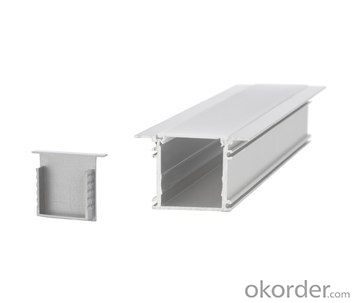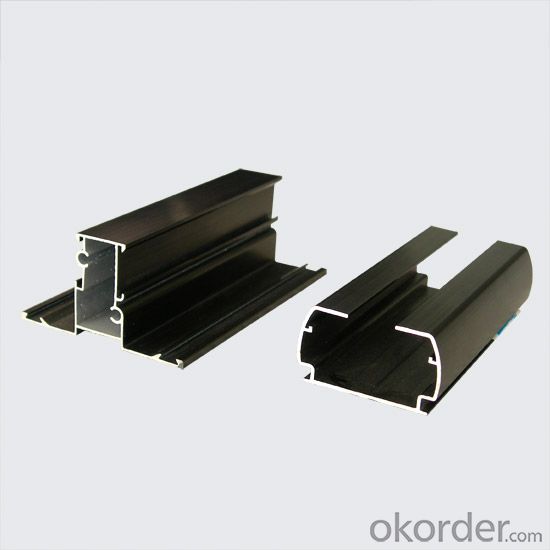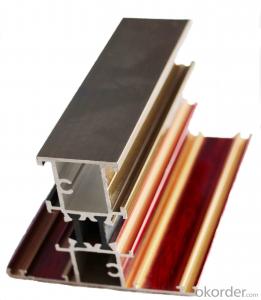Aluminum Profile Indoor Single Face Sand Silver Color Anodized Poster Holder
- Loading Port:
- Shanghai
- Payment Terms:
- TT OR LC
- Min Order Qty:
- 5 m.t.
- Supply Capability:
- 1000 m.t./month
OKorder Service Pledge
OKorder Financial Service
You Might Also Like
Item specifice
1.Structure of Aluminum Profile Indoor Single Face Sand Silver Color Anodized Poster Holder Description:
Anodizing (also spelled anodising, particularly in the UK and Australia) is an electrolytic passivation process used to increase the thickness of the natural oxide layer on the surface of metal parts. Anodized aluminium surfaces, for example, are harder than aluminium but have low to moderate wear resistance that can be improved with increasing thickness or by applying suitable sealing substances.
2.Main Features of the Aluminum Profile Indoor Single Face Sand Silver Color Anodized Poster Holder :
High corrosion-resistance;
weather-resistance;
heat-resistance;
alkali-resistance and impact-resistance properties.
3.Aluminum Profile Indoor Single Face Sand Silver Color Anodized Poster Holder Images:



4.Aluminum Profile Indoor Single Face Sand Silver Color Anodized Poster Holder Specification:
1. Material: 6063,6061,6060,6005,6005A,etc.
2. Temper: T5 or T6
3. Finish: Mill finish, anodizing, powder coating, electrophoresis, wooden transfer or pvdf/carbon-flouride coated, polishing, brushing, sand blasting
4. Various colors: Silver, bronze, black, gold, blue, grey, champagne, bright, etc.
5. Machining: Cutting, punching, drilling, tapping, milling, bending, welding, CNC etc.
5.FAQ:
①How about your company?
A world class manufacturer & supplier of castings forging in carbon steel and alloy steel,is one of the large-scale professional investment casting production bases in China, consisting of both casting foundry forging and machining factory. Annually more than 8000 tons Precision casting and forging parts are exported to markets in Europe, America and Japan. OEM casting and forging service available according to customer’s requirements.
②How to guarantee the quality of the products?
We have established the international advanced quality management system,every link from raw material to final product we have strict quality test;We resolutely put an end to unqualified products flowing into the market. At the same time, we will provide necessary follow-up service assurance.
- Q:How strong are aluminum profiles?
- Aluminum profiles are known for their exceptional strength-to-weight ratio, making them quite strong despite their lightweight nature. They can withstand various loads and stresses, making them suitable for a wide range of applications, including construction, aerospace, automotive, and industrial sectors. Additionally, aluminum profiles can be reinforced or combined with other materials to further enhance their strength and durability.
- Q:Are aluminum profiles suitable for automotive body panels?
- Yes, aluminum profiles are suitable for automotive body panels. Aluminum is a lightweight and strong material, making it ideal for improving fuel efficiency and enhancing overall vehicle performance. Additionally, aluminum profiles offer excellent corrosion resistance, durability, and design flexibility, making them a popular choice for modern automotive applications.
- Q:The company must tender, but it needs material certification, but what do not know exactly?
- Enterprise legal person business license, China Quality Association approved, the national industrial product production permit, 9001 certificate, a copy of tax registration certificate. Surely that will be enough
- Q:Do aluminum profiles have good thermal insulation properties?
- No, aluminum profiles do not have good thermal insulation properties.
- Q:How do aluminum profiles contribute to daylighting strategies?
- Aluminum profiles play a significant role in daylighting strategies by facilitating the efficient use of natural light in buildings. These profiles are used to create windows, skylights, and curtain wall systems, which allow for the maximum entry of sunlight into the interior spaces. One of the primary advantages of using aluminum profiles in daylighting strategies is their ability to support large glass panes. Aluminum is lightweight and structurally strong, enabling the creation of expansive glazing systems that maximize the transmission of natural light. These profiles can be designed to have slim sightlines, providing unobstructed views and allowing more sunlight to enter the building. Moreover, aluminum profiles can be thermally broken, meaning they have a layer of insulation between the interior and exterior aluminum sections. This thermal break prevents the transfer of heat and cold, improving the energy efficiency of the building. By minimizing thermal bridging, aluminum profiles contribute to reducing the loss of heat or cool air, resulting in lower energy consumption for heating and cooling systems. Additionally, aluminum profiles can be finished with various coatings that enhance their daylighting performance. For instance, reflective coatings can be applied to the profiles to redirect sunlight deeper into the interior, increasing the overall brightness of the space. Such coatings can also help reduce glare and control the intensity of sunlight, creating a more comfortable and visually pleasing environment. Furthermore, aluminum profiles offer flexibility in terms of design and customization. They can be shaped into different geometries and sizes, enabling architects to create innovative and unique daylighting solutions. For example, the profiles can be curved, angled, or combined with other materials to achieve specific aesthetic and functional requirements. In summary, aluminum profiles contribute to daylighting strategies by allowing for the efficient use of natural light in buildings. Through their structural strength, thermal performance, and customization possibilities, these profiles enable the creation of large glazing systems that maximize the entry of sunlight while maintaining energy efficiency and visual comfort.
- Q:Are aluminum profiles suitable for noise barriers?
- Indeed, noise barriers can be effectively constructed using aluminum profiles. The durability, corrosion resistance, and lightweight nature of aluminum make it an ideal material for noise barriers. By either absorbing or reflecting sound waves, aluminum profiles can effectively diminish noise pollution. Moreover, the malleability of aluminum offers numerous design possibilities, rendering it highly adaptable for diverse noise barrier applications. Additionally, aluminum is an environmentally conscious choice as it is both recyclable and sustainable. In summary, aluminum profiles are a viable choice for noise barriers owing to their enduring nature, efficacy in noise reduction, and design flexibility.
- Q:Request recommended professional aluminum manufacturer?
- Jing Long aluminum, aluminum strip and aluminum wafer production capacity of 60000 tons, this piece in Shangqiu, still have the strength, is a professional production and processing, wholesale distribution of aluminum, hot-rolled plate, hot rolled plate, aluminum plate, aluminum plate, roll spindle is the main.
- Q:Are there any limitations on the length of aluminum profiles?
- The length of aluminum profiles is subject to limitations. These limitations arise from factors such as the manufacturing process, transportation constraints, and practicality. When it comes to manufacturing, aluminum profiles are typically either extruded or rolled. The length of these profiles is determined by the equipment and capabilities of the manufacturer. The extrusion presses and rolling mills have specific size limitations, which dictate the maximum length of aluminum profiles that can be produced. Transportation constraints also come into play when considering the length of aluminum profiles. Longer profiles may pose logistical challenges during transportation, primarily due to the size of trucks or shipping containers. Moreover, the risk of damage or deformation increases as the length of the profiles increases. Practicality is yet another factor that sets restrictions on the length of aluminum profiles. Longer profiles tend to be less rigid, making them more susceptible to sagging or bending under their own weight. As a result, they may not be suitable for certain applications. Additionally, handling and installing longer profiles may require specialized equipment and techniques. Despite these limitations, manufacturers can often produce aluminum profiles in various lengths to meet specific project requirements. However, it is crucial to consider these limitations and consult with the manufacturer to determine the feasibility of producing longer profiles if necessary.
- Q:Excuse me, aluminum oxidation and electrophoresis have what different?
- Alumina:The substrate is used as an anode to be electrolyzed in an electrolyte, and a protective oxide film is formed on the surface of the substrate artificially so as to form an oxidized aluminum materialMain features of aluminium oxide material:1. It has strong wear resistance, weather resistance and corrosion resistance2, you can form a variety of colors on the substrate surface, the maximum to suit your requirements3, hardness is strong, suitable for all kinds of building, industrial material production
- Q:What is the tolerance of aluminum profile extrusion?
- According to section calculation, the tube can be controlled in the positive and negative 0.05mm square tube, 100 think positive and negative 0.15mm, each mold factory technical process is different, the processing accuracy requirements are different, depending on the product!
1. Manufacturer Overview |
|
|---|---|
| Location | |
| Year Established | |
| Annual Output Value | |
| Main Markets | |
| Company Certifications | |
2. Manufacturer Certificates |
|
|---|---|
| a) Certification Name | |
| Range | |
| Reference | |
| Validity Period | |
3. Manufacturer Capability |
|
|---|---|
| a)Trade Capacity | |
| Nearest Port | |
| Export Percentage | |
| No.of Employees in Trade Department | |
| Language Spoken: | |
| b)Factory Information | |
| Factory Size: | |
| No. of Production Lines | |
| Contract Manufacturing | |
| Product Price Range | |
Send your message to us
Aluminum Profile Indoor Single Face Sand Silver Color Anodized Poster Holder
- Loading Port:
- Shanghai
- Payment Terms:
- TT OR LC
- Min Order Qty:
- 5 m.t.
- Supply Capability:
- 1000 m.t./month
OKorder Service Pledge
OKorder Financial Service
Similar products
New products
Hot products
Related keywords































